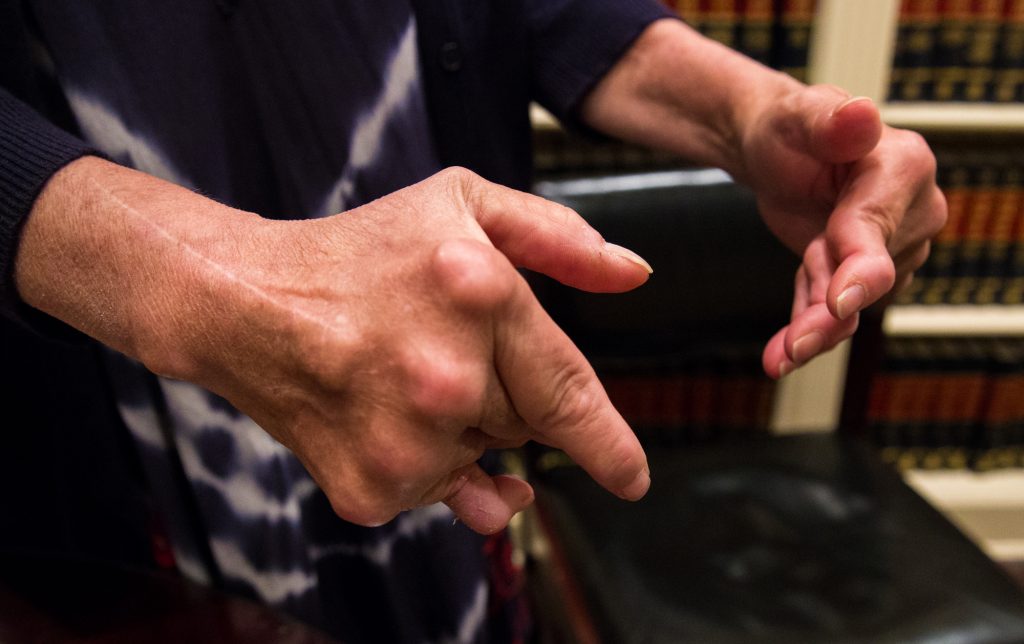Legionnaires’ survivor: ‘I’m lucky to be alive’

When Lori Clark woke up from a 43-day medically induced coma, she realized she could no longer mover her limbs. Doctors placed Clark in a coma to try and treat Legionnaires’ disease she contracted at a hotel in New York state. (Photo by Karl Schneider/News21)
ALBANY, N.Y. – Doctors twice notified Lori Clark’s family that they expected her to die.
Clark, a project manager who lives in upstate New York, was placed in a chemically induced coma for 43 days after she was diagnosed with Legionnaires’ disease in 2011. She initially thought she had the flu and delayed seeing a doctor. The last thing she remembers before waking up from the coma is her son rushing her to hospital.
“I couldn’t feel my limbs, was coughing all the time and had a really high temperature,” she said.
Legionnaires’ disease is a severe form of pneumonia caused by the waterborne bacteria legionella. People may contract Legionnaires’ when they breathe in water mists contaminated with legionella, or when drinking water goes down the wrong pipe and into the lungs. The Centers for Disease Control and Prevention says people above the age of 50 or those with underlying health conditions are most at risk from the disease.
Clark was 46 years old when she was diagnosed. She also suffers from rheumatoid arthritis and lupus, and she went into septic shock and organ failure after contracting Legionnaires’ disease. Her fingers caved in while she was in the coma because she couldn’t take her arthritis medication, she said.
“Before Legionnaires’? I could walk. I could run. I could ride my bike. I could garden, and I could bend over. Life after legionnaires? Not so much,” said Clark, now 54. “I will never see another country unless they build a bridge. I will never get on a plane after this as I’m more susceptible to pneumonia now. I can no longer type properly as my fingers curled up while I was in the coma… Legionella is a killer, and people need to pay more attention to it.”
Legionnaires’ wasn’t something that ever concerned Clark before her diagnosis. She knew it existed, but she never thought she was at risk. Now, after the disease nearly killed her, she finds herself angered by the fact that thousands of people are affected by this waterborne illness every year.
“I’m reading about it in the news every day. How could I not be mad?” she said. “People in power need to see the light and understand that they are playing with people’s lives. They’re shirking their responsibility for the public’s health. I invite them to go through what I went through.”
Clark’s lungs now only function at 50 percent capacity. She has to work from home most days, and she can no longer travel by airplane or do the hobbies she once enjoyed.

Doctors diagnosed Lori Clark with Legionnaires’ disease in January 2011. Clark first noticed symptoms when she began coughing after a visit to a hotel in New York state. Doctors induced Clark into a chemical coma for 43 days to try and treat the disease. (Photo by Karl Schneider/News21)
“Mentally, it gets easier. Physically, it doesn’t,” she said. “Anxiety levels subside after a while, but in the beginning, I felt like I was walking through a minefield every time I went out in public. I was like a ticking timebomb. If I couldn’t tie my shoe. I would fly off the handle.”
Potable water is one of the most common sources of legionella, according to the Environmental Protection Agency. But health experts argue that officials tend to ignore drinking water supplies when it comes to identifying sources of legionella contamination.
Brad Considine, director of strategic planning with the Alliance to Prevent Legionnaires’ Disease, said officials need to start “facing the facts.”
“When outbreaks happen, health departments look to cooling towers and air-conditioning systems, but research shows potable water is the often the main source,” Considine said.
“By ignoring domestic water systems, they are putting people’s health at risk. We were given bodies that fend off all these threats that we live with, but there’s some things we shouldn’t have to fight.”
Clark sued the hotel where she contracted Legionnaires’ for negligence.
She was there for a three-day work event, and she used the spa and pool facilities, the restrooms and drank the water. A week later, she was fighting for her life. It turned out the hotel never informed guests that elevated levels of legionella had been found in the water system a month earlier, she said.
Health inspectors said it was possible she contracted it from the spa and pool, but like in most Legionnaires’ cases, it is difficult to identify the exact source.
Her attorney, Michael Conway, of Harris, Conway & Donovan, said most Legionnaires’ cases settle as people don’t want it known publicly that their water systems are contaminated.
“Because it’s often difficult to identify the source of contamination, people tend not to take legal action as they believe they’re fighting a losing battle,” he said.
The CDC reports that about one in 10 people die from the lung condition, and Clark considers herself lucky to be on the right side of that statistic. The CDC also says that legionella has been responsible for 66 percent of waterborne disease outbreaks associated with drinking water in the U.S., while the number of cases has risen since 2000.
For Clark, that’s the most frustrating part. In her opinion, officials aren’t dealing with the problem.
“It’s entirely preventable. That’s one of the saddest things,” she said. “None of this has to happen. I feel for the families and the individuals who have to go through this. I’m lucky to be alive.”
To see the full News21 report on “Troubled Water,” go to troubledwater.news21.com on Aug. 14.